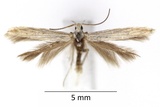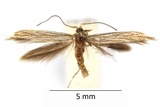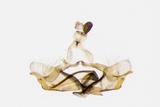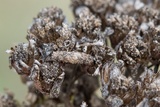Coleophora argentula (Stephens, 1834) Species
Last modified: Nov. 27, 2025, 6:40 p.m.
A not so common species throughout Belgium.
Details
- Classification
- Family: Coleophoridae > Genus: Coleophora > Species: Coleophora argentula
- Vernacular names
- Duizendbladkokermot (NL), Yarrow case-bearer (EN), Schafgarben-Sackmotte (DE)
- Synonyms
- Coleophora cothurnella (Duponchel, 1843)
- First mention in Belgium
- De Crombrugghe G. 1901. Note sur quelques Microlépidoptères de la faune belge. — Annales de la Société Entomologique de Belgique 45: 100–104. On page 102 (as Coleophora argentula Z.). view page
- Status
-
Native
Distribution
Case
The larva forms a silken case, white when juvenile, but a brown, tri-valved tubular silken case when full-grown.
This case is at that moment about 5–6 mm long and the mouth angle is 0°–20°.
See also bladmineerders.be.
Bionomics
The eggs are oviposited on the flowers of the food plant. The larvae feed on the flowers and the seeds living inside a brown silken case. The caterpillars can easily be found on the florets of the hostplant from mid-August till well in October.
In general, the fully developed larvae leave the plant to hibernate. Pupation takes place inside the case on ground level or on the florets.
The adults are night-active from the evening till sunrise and come infrequently to light.
Flight periods
C. argentula flies in July and August in one generation.
Observed on
- Host plant (species):
- Achillea millefolium and Achillea ptarmica
- Host plant (genera):
- Achillea
Achillea millefolium is mostly taken but sometimes also A. ptarmica.










